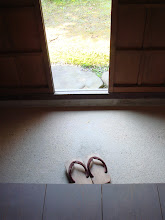 It's pickle time!
It's pickle time!In the list of favorite foods that resides in my head, pickles certainly take one of the top five spots (there are probably about 10 different foods fighting for the top 5 spots, which I guess could be a little troublesome). This weekend I realized that I am running low on pickles, so its time re-stock the pickle jar.
I like this recipe for sweet cucumber pickles, they are refreshing, lightly sweet and have a small kick of heat at the end.
Sweet Cucumber Pickles
Ingredients
5 Japanese cucumbers
1 2/3 Tbsp of salt
1 1/2 cups of rice vinegar
1/2 cup of water
1/4 cup of sugar
2 pods of dried chilli pepper
1 bay leaf
1 small cinnamon stick
6-7 peppercorns
1 pickling press
1 glass jar
Method
First, wash the cucumbers and trim off the edges (otherwise they will taste bitter). Once they are clean, cut them lengthwise in half. Mine will look a little smaller because my pickling jar is small, so I cut them into smaller pieces.

Lay the cucumbers in the pickling press and add salt, rub the cucumbers to make sure that the salt is evenly distributed. Then, pour over 1/3 of salted water to make sure the salt is soaked into the cucumbers evenly
Put on the lid of the pickle press and screw down to place weight on the cucumbers. this will allow the water to drain out of the cucumbers and the pickling process to begin. Store them away from the sun from 12-24 hours.

Take the pickles out of the press and rinse them to remove excess water. Put the pickles in the shade and let their surface dry.

In the meantime, heat up the marinade for the pickles using the remaining ingredients. Make sure the marinade never touches any metallic objects (that includes measuring cups, spoons or the pot). Rice vinegar reacts to metallic objects and develops an unpleasant, metallic taste. Some people have enamel covered pots that work quite well. I don't have one, so I use a Latin technique called "Bano de Maria", I heat up a ceramic bowl within a pot of boiling water and place the marinade inside the bowl. Bring the marinade to a boil , then turn off the heat and let it cool.

Finally, pack cucumbers in a pickling jar, and pour over the marinade. Let them soak in the flavors of the marinade for one day. These pickles will be good for a couple of months!











 I don't think anything I have seen before prepared us for our stay at the
I don't think anything I have seen before prepared us for our stay at the 








